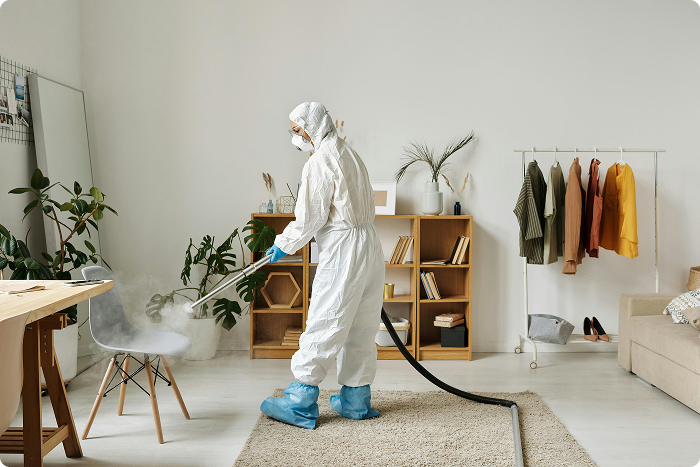Home Damage & Health Risks: Dealing with Termite Damage, Allergic Reactions, Pests in Walls, and Preventing Pest Diseases
By Kurt Woodard · Jul 25, 2025

Home damage and the health risks associated with pest infestations can be substantial. From the structural deterioration caused by termites to the allergic reactions triggered by pests, it's essential to understand and address these dangers. Pests in walls can go unnoticed for long periods, compounding the damage and health risks. This article will explore how to identify, manage, and prevent termite damage, allergic reactions, and the presence of pests in your home, while also offering insights into preventing pest-related diseases. Keep reading to arm yourself with the knowledge needed to protect your home and health.
Understanding Home Damage from Pests
The Destructive Power of Termites
Termites can be one of the most devastating pests for homeowners. Silent destroyers, they cause extensive damage before being noticed.
- Structural Damage: Termites feed on wood and other cellulose materials, compromising the integrity of your home's structure.
- Signs of Termite Damage:
- Mud Tubes: Pencil-sized tunnels on exterior walls or in crawl spaces.
- Damaged Wood: Hollow-sounding wood, blistering, or darkening.
- Swarmers: Finding discarded wings or seeing winged termites.
Pests in Walls: Hidden Threats
Pests taking refuge in walls can remain undetected while causing extensive damage.
- Rodents: Mice and rats gnaw on electrical wires, posing fire hazards.
- Insects: Termites, ants, and other insects weaken structures by creating tunnels and nesting.
- Raccoons and Squirrels: Can damage insulation and structural elements while making nests.
Health Risks from Pests
Allergic Reactions to Pests
Pests can trigger allergic reactions and exacerbate respiratory conditions.
- Cockroaches: Droppings and shed skins can cause allergies and asthma.
- Dust Mites: Their waste products are a common allergen, triggering symptoms like sneezing and itching.
- Stinging Insects: Bees, wasps, and hornets can cause severe allergic reactions in sensitive individuals.
Preventing Pest-Related Diseases
Pests are carriers of various diseases. Effective prevention is crucial to safeguard health.
- Rodents: Rodents can spread Hantavirus, Leptospirosis, and Salmonella.
- Mosquitoes: Known for transmitting diseases such as West Nile Virus, Dengue Fever, and Zika.
- Ticks: Spread Lyme disease and other tick-borne illnesses.
Managing Termite Damage
Conducting Termite Inspections
Regular termite inspections can prevent extensive damage.
- Professional Inspection: Hire licensed pest control experts annually or semi-annually.
- DIY Checks: Periodically inspect basements, crawl spaces, and attics for signs like mud tubes or damaged wood.
Termite Control Methods
Control methods include chemical treatments, bait systems, and structural repairs.
- Chemical Treatments: Using termiticides to create barriers and eliminate colonies.
- Bait Systems: Stakes implanted around the home to attract and kill termites.
- Physical Barriers: Stainless steel mesh or sand barriers in new constructions.
Addressing Pests in Walls
Identifying Pests in Walls
Different signs and methods help identify pests hiding in your walls.
- Noises: Scratching, scurrying, or chewing sounds within walls.
- Droppings: Finding pest droppings around baseboards or in attics.
- Odors: Unusual smells from decomposing pests or their nests.
Effective Removal Techniques
Professional removal is often required to address pests in walls safely and effectively.
Rodents
- Trapping and Exclusion: Using traps and sealing entry points.
- Professional Extermination: Engaging professionals for severe infestations.
Insects
- Chemical and Non-Chemical Treatments: Insecticides and desiccant dust.
- Heat Treatments: Effective for termite and insect infestations.
Larger Pests
- Humane Traps: Catch and release methods for raccoons or squirrels.
- Professional Removal: Hiring wildlife control experts.
Preventing Future Infestations
- Seal Entry Points: Inspect and caulk gaps around your home.
- Maintain Cleanliness: Reduce clutter and store food in sealed containers.
- Regular Inspections: Conduct seasonal inspections to catch early signs of infestations.
Preventing Allergic Reactions
Mitigating Indoor Allergens
Reducing allergens in your home involves thorough and regular cleaning practices.
- Regular Vacuuming: Use HEPA filters to capture small particles like dust mites.
- Air Purifiers: Effective in reducing airborne allergens.
- Moisture Control: Dehumidifiers can prevent mold growth which can attract pests.
Professional Pest Control
Professional pest control can address and prevent infestations causing allergic reactions.
- Regular Treatments: Schedule regular pest control treatments.
- Allergen Reduction: Services specifically targeting allergenic pests like cockroaches.
- Pest Proofing: Professional sealing of gaps and cracks to prevent entry.
Preventing Pest-Related Diseases
Maintaining a Pest-Free Environment
Maintaining a pest-free home protects against diseases.
- Sanitation: Keep your home clean; promptly dispose of garbage.
- Regular Maintenance: Repair leaks and avoid standing water.
- Pest Monitoring: Use traps and monitors to detect pest presence early.
Vaccinations and Health Precautions
Keeping up-to-date with vaccinations and taking health precautions can prevent disease transmission.
- Vaccinate Pets: Ensure your pets are vaccinated against common diseases carried by pests.
- Use Repellents: Apply insect repellents when engaging in outdoor activities.
- Protect Against Bites: Wear long sleeves and pants in areas prone to ticks or mosquitoes.
Conclusion
Home damage and health risks from pests can be mitigated with proactive measures. Regular inspections, pest-proofing your home, and professionally managing infestations are essential steps to protect your home and health. Understanding the importance of addressing termite damage, allergic reactions, and the presence of pests in walls helps maintain a safe and comfortable living environment.
For further assistance or to connect with trusted professionals capable of dealing with pest issues, consider using HouzTask AI. Visit HouzTask AI to ask questions or Find a Pro to connect with experts.
Need help?
Let HouzTask help you diagnose the issue or connect with a trusted local pro — in minutes.
Get Started with HouzTask